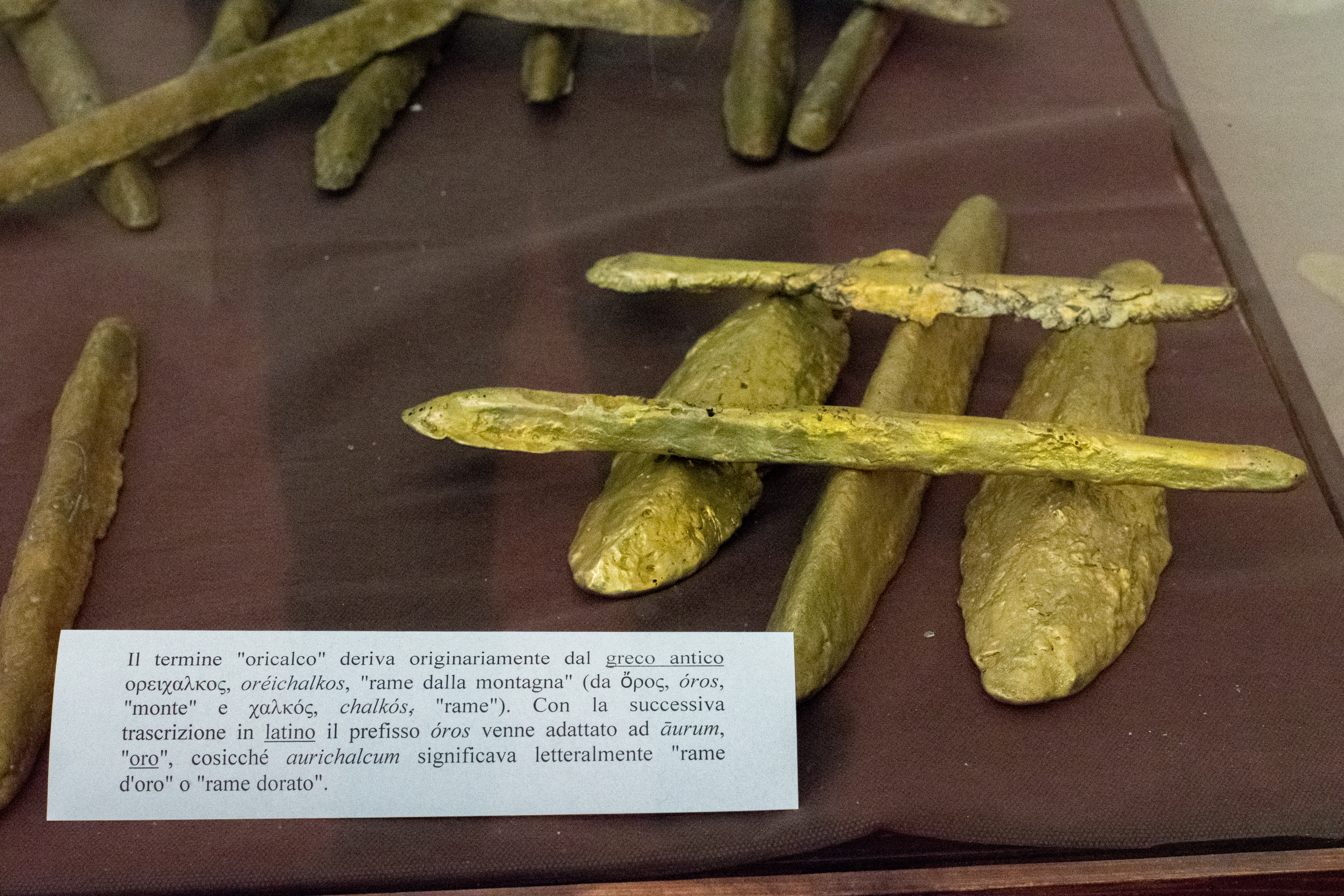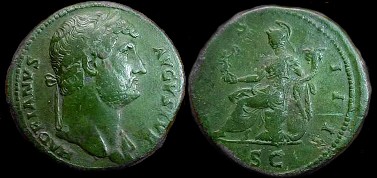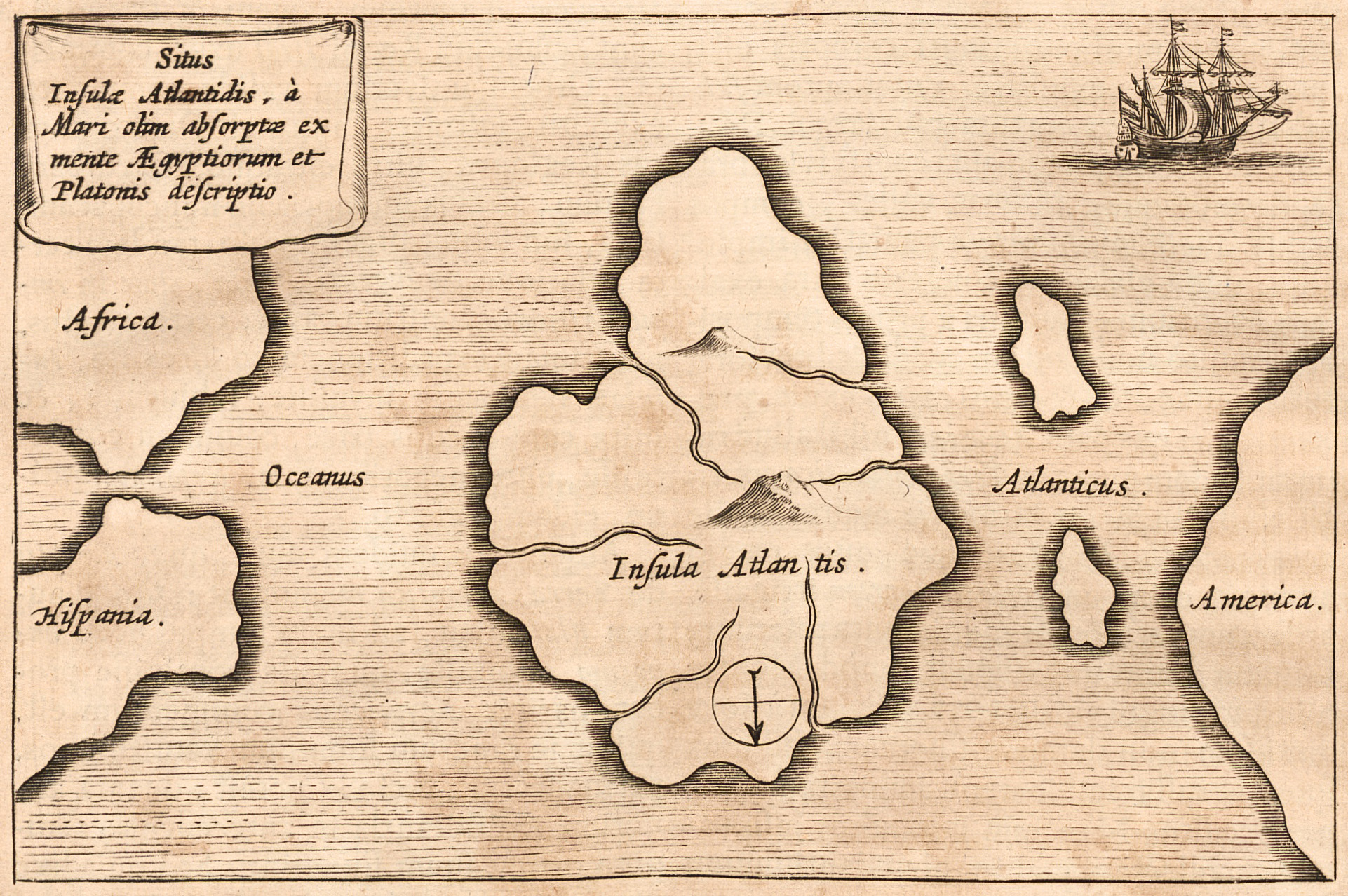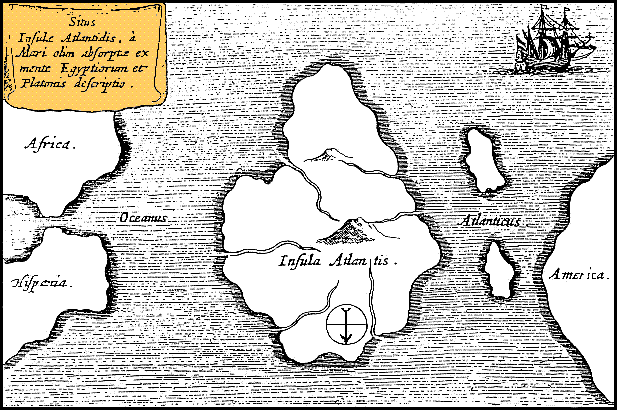|
Orichalcum
Orichalcum or aurichalcum is a metal mentioned in several ancient writings, including the story of Atlantis in the ''Critias'' of Plato. Within the dialogue, Critias (460–403 BC) claims that orichalcum had been considered second only to gold in value and had been found and mined in many parts of Atlantis in ancient times, but that by Critias's own time orichalcum was known only by name. Orichalcum may have been a noble metal such as platinum, as it was supposed to be mined, or one type of bronze or brass or possibly some other metal alloy. Overview The name is derived from the Greek , ' (from , ', mountain and , ', copper), meaning literally "mountain copper". The Romans transliterated "orichalcum" as "aurichalcum", which was thought to mean literally "gold copper". It is known from the writings of Cicero that the metal which they called orichalcum resembled gold in color but had a much lower value. In Virgil's ''Aeneid'', the breastplate of Turnus is described as "stif ... [...More Info...] [...Related Items...] OR: [Wikipedia] [Google] [Baidu] |
Brass
Brass is an alloy of copper (Cu) and zinc (Zn), in proportions which can be varied to achieve different mechanical, electrical, and chemical properties. It is a substitutional alloy: atoms of the two constituents may replace each other within the same crystal structure. Brass is similar to bronze, another copper alloy, that uses tin instead of zinc. Both bronze and brass may include small proportions of a range of other elements including arsenic (As), lead (Pb), phosphorus (P), aluminium (Al), manganese (Mn), and silicon (Si). Historically, the distinction between the two alloys has been less consistent and clear, and modern practice in museums and archaeology increasingly avoids both terms for historical objects in favor of the more general "copper alloy". Brass has long been a popular material for decoration due to its bright, gold-like appearance; being used for drawer pulls and doorknobs. It has also been widely used to make utensils because of its low melting ... [...More Info...] [...Related Items...] OR: [Wikipedia] [Google] [Baidu] |
Sestertius
The ''sestertius'' (plural ''sestertii''), or sesterce (plural sesterces), was an Ancient Rome, ancient Roman Roman currency, coin. During the Roman Republic it was a small, silver coin issued only on rare occasions. During the Roman Empire it was a large brass coin. The name ''sestertius'' means "two and one half", referring to its nominal value of two and a half ''as (Roman coin), asses'' (a bronze Roman coin, singular ''as''), a value that was useful for commerce because it was one quarter of a denarius, a coin worth ten ''asses''. The name is derived from ''semis'', "half" and "tertius", "third", in which "third" refers to the third ''as'': the sestertius was worth two full ''asses'' and half of a third. English-language sources routinely use the original Latin form ''sestertius'', plural ''sestertii''; but older literature frequently uses ''sesterce'', plural ''sesterces'', ''terce'' being the English equivalent of ''tertius''. A modern shorthand for values in sestertii i ... [...More Info...] [...Related Items...] OR: [Wikipedia] [Google] [Baidu] |
Atlantis
Atlantis ( grc, Ἀτλαντὶς νῆσος, , island of Atlas (mythology), Atlas) is a fictional island mentioned in an allegory on the hubris of nations in Plato's works ''Timaeus (dialogue), Timaeus'' and ''Critias (dialogue), Critias'', wherein it represents the antagonist naval power that besieges "Ancient Athens", the Counterfactual history, pseudo-historic embodiment of Plato's ideal state in ''The Republic (Plato), The Republic''. In the story, Athens repels the Atlantean attack unlike any other nation of the Ecumene, known world, supposedly bearing witness to the superiority of Plato's concept of a state. The story concludes with Atlantis falling out of favor with the deities and submerging into the Atlantic Ocean. Despite its minor importance in Plato's work, the Atlantis story has had a considerable impact on literature. The allegorical aspect of Atlantis was taken up in utopian works of several Renaissance writers, such as Francis Bacon's ''New Atlantis'' and Th ... [...More Info...] [...Related Items...] OR: [Wikipedia] [Google] [Baidu] |
Critias (dialogue)
''Critias'' (; el, Κριτίας), one of Plato's late Socratic dialogue, dialogues, recounts the story of the mighty island kingdom Atlantis and its attempt to conquer Athens, which failed due to the ordered society of the Athenians. ''Critias'' is the second of a projected trilogy of dialogues, preceded by ''Timaeus (dialogue), Timaeus'' and followed by ''Hermocrates (dialogue), Hermocrates''. The latter was possibly never written and the ending to ''Critias'' has been lost. Because of their resemblance (e.g., in terms of persons appearing), modern classicists occasionally combine both ''Timaeus'' and ''Critias'' as ''Timaeus-Critias''. Protagonists *Timaeus of Locri, Timaeus Unlike the other speakers of the ''Critias'', it is unclear whether Timaeus is a historical figure or not. While some classicists regard him as definitively historical, others guess that "Plato's picture of him has probably borrowed traits from various quarters". Frank assumes Archytas of Taranto, Tarent ... [...More Info...] [...Related Items...] OR: [Wikipedia] [Google] [Baidu] |
Turnus
Turnus ( grc, Τυρρηνός, Tyrrhênós) was the legendary King of the Rutuli in Roman history, and the chief antagonist of the hero Aeneas in Virgil's ''Aeneid''. According to the ''Aeneid'', Turnus is the son of Daunus and the nymph Venilia and is brother of the nymph Juturna. Historical tradition While there is a limited amount of information in historical sources about Turnus, some key details about Turnus and the Rutuli differ significantly from the account in the Aeneid. The only source predating the Aeneid is Marcus Portius Cato's Origines. Turnus is also mentioned by Livy in his ''Ab Urbe Condita'' and by Dionysius of Halicarnassus in his (''Rômaïkê Archaiologia'', "''Roman Antiquities''"), both of which come later than the ''Aeneid''. Turnus is mentioned in the Book of Jasher, along with Angeas of Africa. In all of these historical sources, Turnus' heritage is unclear. Dionysius calls him ''Tyrrhenus'', which means "Etruscan", while other sources suggest a ... [...More Info...] [...Related Items...] OR: [Wikipedia] [Google] [Baidu] |
Zinc
Zinc is a chemical element with the symbol Zn and atomic number 30. Zinc is a slightly brittle metal at room temperature and has a shiny-greyish appearance when oxidation is removed. It is the first element in group 12 (IIB) of the periodic table. In some respects, zinc is chemically similar to magnesium: both elements exhibit only one normal oxidation state (+2), and the Zn2+ and Mg2+ ions are of similar size.The elements are from different metal groups. See periodic table. Zinc is the 24th most abundant element in Earth's crust and has five stable isotopes. The most common zinc ore is sphalerite (zinc blende), a zinc sulfide mineral. The largest workable lodes are in Australia, Asia, and the United States. Zinc is refined by froth flotation of the ore, roasting, and final extraction using electricity ( electrowinning). Zinc is an essential trace element for humans, animals, plants and for microorganisms and is necessary for prenatal and postnatal development. It ... [...More Info...] [...Related Items...] OR: [Wikipedia] [Google] [Baidu] |
Chalcopyrite
Chalcopyrite ( ) is a copper iron sulfide mineral and the most abundant copper ore mineral. It has the chemical formula CuFeS2 and crystallizes in the tetragonal system. It has a brassy to golden yellow color and a hardness of 3.5 to 4 on the Mohs scale. Its streak is diagnostic as green-tinged black. On exposure to air, chalcopyrite tarnishes to a variety of oxides, hydroxides, and sulfates. Associated copper minerals include the sulfides bornite (Cu5FeS4), chalcocite (Cu2S), covellite (CuS), digenite (Cu9S5); carbonates such as malachite and azurite, and rarely oxides such as cuprite (Cu2O). Is rarely found in association with native copper. Chalcopyrite is a conductor of electricity. Etymology The name chalcopyrite comes from the Greek words , which means copper, and ', which means striking fire. It was sometimes historically referred to as "yellow copper". Identification Chalcopyrite is often confused with pyrite and gold since all three of these minerals have a yell ... [...More Info...] [...Related Items...] OR: [Wikipedia] [Google] [Baidu] |
Joseph Needham
Noel Joseph Terence Montgomery Needham (; 9 December 1900 – 24 March 1995) was a British biochemist, historian of science and sinologist known for his scientific research and writing on the history of Chinese science and technology, initiating publication of the multivolume ''Science and Civilisation in China''. He was elected a fellow of the Royal Society in 1941 and a fellow of the British Academy in 1971. In 1992, Queen Elizabeth II conferred on him the Companionship of Honour, and the Royal Society noted he was the only living person to hold these three titles. Early life Needham's father, Joseph was a doctor, and his mother, Alicia Adelaïde, née Montgomery (1863–1945), was a music composer from Oldcastle, County Meath, Ireland. His father, born in East London, then a poor section of town, rose to became a Harley Street physician, but frequently battled with Needham's mother. The young Needham often mediated. In his early teens, he was taken to hear the Sun ... [...More Info...] [...Related Items...] OR: [Wikipedia] [Google] [Baidu] |
Richard Watson (bishop Of Llandaff)
Richard Watson (1737–1816) was an Anglican bishop and academic, who served as the Bishop of Llandaff from 1782 to 1816. He wrote some notable political pamphlets. In theology, he belonged to an influential group of followers of Edmund Law that included also John Hey and William Paley. Life Watson was born Heversham, Westmorland (now Cumbria), and educated at Heversham Grammar School and Trinity College, Cambridge, on a scholarship endowed by Edward Wilson of Nether Levens (1557–1653). In 1759 he graduated as Second Wrangler after having challenged Massey for the position of Senior Wrangler. This challenge, in part, prompted the University Proctor, William Farish, to introduce the practice of assigning specific marks to individual questions in University tests and, in so doing, replaced the practice of 'judgement' at Cambridge with 'marking'. Marking subsequently emerged as the predominant method to determine rank order in meritocratic systems. In 1760 he became a fellow of ... [...More Info...] [...Related Items...] OR: [Wikipedia] [Google] [Baidu] |
X-ray Fluorescence
X-ray fluorescence (XRF) is the emission of characteristic "secondary" (or fluorescent) X-rays from a material that has been excited by being bombarded with high-energy X-rays or gamma rays. The phenomenon is widely used for elemental analysis and analytical chemistry, chemical analysis, particularly in the investigation of metals, glass, ceramics and building materials, and for research in geochemistry, forensic science, archaeology and art objects such as paintings. Underlying physics When materials are exposed to short-wavelength X-rays or to gamma rays, ionization of their component atoms may take place. Ionization consists of the ejection of one or more electrons from the atom, and may occur if the atom is exposed to radiation with an energy greater than its ionization energy. X-rays and gamma rays can be energetic enough to expel tightly held electrons from the inner atomic orbital, orbitals of the atom. The removal of an electron in this way makes the electronic structu ... [...More Info...] [...Related Items...] OR: [Wikipedia] [Google] [Baidu] |
Cambridge University Press
Cambridge University Press is the university press of the University of Cambridge. Granted letters patent by Henry VIII of England, King Henry VIII in 1534, it is the oldest university press A university press is an academic publishing house specializing in monographs and scholarly journals. Most are nonprofit organizations and an integral component of a large research university. They publish work that has been reviewed by schola ... in the world. It is also the King's Printer. Cambridge University Press is a department of the University of Cambridge and is both an academic and educational publisher. It became part of Cambridge University Press & Assessment, following a merger with Cambridge Assessment in 2021. With a global sales presence, publishing hubs, and offices in more than 40 Country, countries, it publishes over 50,000 titles by authors from over 100 countries. Its publishing includes more than 380 academic journals, monographs, reference works, school and uni ... [...More Info...] [...Related Items...] OR: [Wikipedia] [Google] [Baidu] |
Aeneid
The ''Aeneid'' ( ; la, Aenē̆is or ) is a Latin Epic poetry, epic poem, written by Virgil between 29 and 19 BC, that tells the legendary story of Aeneas, a Troy, Trojan who fled the Trojan_War#Sack_of_Troy, fall of Troy and travelled to Italy, where he became the ancestor of the Ancient Rome, Romans. It comprises 9,896 lines in dactylic hexameter. The first six of the poem's twelve books tell the story of Aeneas' wanderings from Troy to Italy, and the poem's second half tells of the Trojans' ultimately victorious war upon the Latins (Italic tribe), Latins, under whose name Aeneas and his Trojan followers are destined to be subsumed. The hero Aeneas was already known to Greco-Roman legend and myth, having been a character in the ''Iliad''. Virgil took the disconnected tales of Aeneas' wanderings, his vague association with the foundation of Ancient Rome, Rome and his description as a personage of no fixed characteristics other than a scrupulous ''pietas'', and fashioned th ... [...More Info...] [...Related Items...] OR: [Wikipedia] [Google] [Baidu] |









.jpg)


